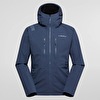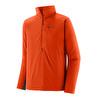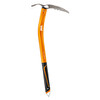Jasper climbs Vertical limits M12 E2
On 25.01.03 Robert Jasper redpointed what he believes to be his hardest creation ever, "Vertical limits", M12 E2 in the drytooling hotspot Ueschenen in Switzerland’s Bernese Oberland.
| On 25.01.03 Robert Jasper redpointed what he believes to be his hardest creation ever, "Vertical limits", in the drytooling hotspot Ueschenen in Switzerland’s Bernese Oberland. The route in question is a stunning 35m roof which, much to his own surprise, he managed to repoint 5th go. Jasper believes "Vertical limits" to be similar to Will Gadd’s Canada testpiece "Musashi", graded M12. Given the run-outs and possible ground fall from the fourth bolt, Jasper adds E2. For an explanation of Jasper's proposed new grading system which, much like the British scale, incorporates the psychological aspect of a route, see below. |
| |||||||||||||||
E-Grading - to know the risk! by Robert Jasper The present-day German, French and American grading scales don’t convey any information about how serious a mixed route is, and I therefore propose the E-grading system. This helps to differentiate, as it’s obviously a totally different thing to climb a M9 which is bolted like a sportclimb, or a M9 where you have to place your own gear! In Great Britain there is already an E-grading scale which offers this information, but it interferes in some points with the UIAA Scale and, like a normal grading scale, is still open and can therefore increase further. As a addition to the UIAA scale and the mixed (M) and the waterice (W) scale, the E-grade makes sense because it is closed and clearly defined! It takes into account the quality of the protection, the danger of injury and the psychological demands, all of which have three levels:
3 points = E1 4 points = E2 5 points = E3 7 points = E4 8 points = E5 9 points = E6 A E1 route is well protected, there is a low risk of injury and consequently the psycholgical demands are practically non existant. A E6 route on the otherhand has poor/bad protection, the risk of injury is high and consequently the climber has to overcome great psycholgical demands. Three examples Route: „White out“: M10/E1 Location: Isenfluh, Switzerland Protection: Good= 1 point Danger of injury: Low = 1 point Psychological demands: No fear = 1 point Total: 3 points = E1 Route: Flying circus M10/ E4 Location: Kandersteg, Switzerland Protection: Fair =2 points Danger of injury: Moderate =2 points Psychological demands: Fear = 2 points Total: 6 points = E4 Route: Beta Block Super: W7/E6 Location: Kandersteg, Switzerland Protection: Bad =3 points Danger of injury: high =3 points Psychological demands: Big Fear = 3 points Total: 9 points = E6 | ||||||||||||||||
Latest news
Expo / News
Expo / Products
Hardshell jacket for technical mountaineering and climbing.
Climbing Technology Climbing Technology Altimate - harness for ski touring and technical mountaineering
Innovative double configuration modular harness designed for ski touring and technical mountaineering.
A versatile high performance three season layering piece perfect for the summer months.
Technical footwear for high altitude mountaineering and ice climbing.
Technical performance ice axes for classic mountaineering Petzl Summit Evo.
Kunene Jacket Woman is an ultra light jacket that takes up a minimum of space.



 Copia link
Copia link

























